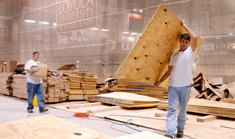Construction work on the Recreational Sports Complex is more than a month behind schedule after workers from Wood Floor Finishers discovered an uneven, flawed concrete surface beneath the old tennis courts.
The process of converting the eastern half of the gym from tennis and badminton courts to a full-size basketball court began in December.
Originally, a low-bid contract was signed with the floor company from Mandeville for $133,000 for work to be finished by Jan. 10. Now, the job will cost $180,000 and be completed in early March.
Nan Davis, director of recreational sports, said that replacing the carpet was necessitated by health concerns.
According to Davis, the project had been in the planning stages for several years.
“The carpet was starting to unravel, and we had repaired it with tape. Now, that makes no sense for a gymnasium to have to tape its floors together.”
Davis said that the carpet surface, called Pro-Gym, had been popular for many years but had recently been found to cause serious injuries.
“The coefficient of friction was so high that feet would stick, but knees would keep going, which led to a lot of knee surgeries and lawsuits,” Davis said.
She added that, although the stated lifespan of the product was 10 years, the current floor was 17 years old.
When workers tore out the carpeted tennis courts, they found that the concrete slab underneath was cracked and uneven.
Eddie Sharp, the foreman of the current construction team, said that a flat, even concrete slab is vital to a quality, long-lasting court and that degraded surfaces are common.
“Sanding [leveling the floor] is a normal procedure for us,” Sharp said. “The most time-consuming step in the process is letting the concrete cure.”
With Louisiana’s extreme humidity, special precautions must be taken to ensure a long-lasting floor, but the process usually takes up to a month, Sharp said.
Sharp added that, in order to prevent the wood from buckling, workers had to give the floor time to acclimate to the humidity of the gym. In addition, workers will leave spaces around the edge of the floor, to give it room to expand with humidity.
The new floor is “higher end,” according to Sharp. The first layer of plywood rests on rubber cushions, which adds spring and is gentler on athletes’ bodies.
Sharp said construction is downhill from here, without any special complications.
“This is a gravy job. The floors, after what they did, are perfect,” Sharp said.
The added expense of pouring and resurfacing the slab has raised costs almost $50,000, but Davis said that the school will absorb the expense.
“I had originally budgeted $150,000 for this project, and we have money in reserves for emergencies and building expenses,” Davis said.
Davis said she expects the new surface to serve the needs ofLoyola well.
“Wood meets the highest demand, and we’ve found special tennis balls for the wood surface. We’ve talked to some of our regular tennis players, and they’re very excited,” she said.
Jennifer Vu, philosophy/history sophomore and one of the RecPlex’s building managers, agreed that the building needed change.
She said that demand, based on reservation sheets, was calculated over several months and basketball courts were rarely available.
When finished, the area will house a full-size basketball court and the ability to transform to two smaller basketball courts, three volleyball courts, two tennis courts or four badminton courts.
Kelly Brown can be reached at kwbrown@loyno.edu






